
Publisher: Lock n’ Load Publishing
Designer: Gottardo Zancani
Artist: Blackwell Hird
Year: 2010
Players: Solitaire
Ages: 13+ (my estimate)
Playing Time: 45 Minutes
Genre: Solitaire science fiction wargame
Retail Price: $54.99
It’s the future and we are at war. You are in charge of a squad of Space Infantry assigned the difficult task of infiltrating the enemy’s position and accomplishing your mission. The missions range from simple investigation, to search and destroy, rescue, and others. The basic game comes with eight missions, while the advanced game offers an additional six missions that include randomly generated maps.
Space Infantry is a solitaire game in the tradition of B-17: Queen of the Skies, at least in certain ways. In other ways, it is completely unique.
Upon opening the box you will find maps, counters, some cards and the rules. These are all very well done and nicely illustrated. The hive tiles are a little on the thin side, but they did not give me any problems.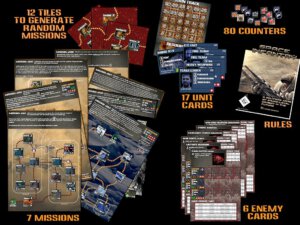
The rules are fairly well done and have many examples, including a full play example in the back of the book. Despite this, I did have some difficulty in figuring out exactly what I needed to do to play the game. The rules are long, but are divided into separate sections for the basic game, advanced game, and campaign game. There are also optional rules that you can use or avoid as you see fit.
For your first game you will find yourself stumbling a bit. I don’t like it when you have to remember the minutia rules like “In situation X always apply a -1 modifier to your Y”. There is some of this going on in Space Infantry, and I found myself constantly paging through the rules to find this or that. There is a Quick Reference page on the back of the rulebook that really helped out with some of this. There is a lot of cryptography, or terminology I should say, that you have to learn to understand the game. For example an Event String consists of two parts, Scope and Class, or <scope>/class. It actually isn’t used to program in C++, and it isn’t as difficult to figure out as it seems once you understand it.
So the way I approached it was to read the basic rules, then play a mission to get some playing experience. Since it is a solitaire game, this is easy enough to do.
You get 110 points to spend on selecting units for your squad. These are cards with various titles like Fire Team A, Close Combat Team, Scientist, Technician, squad leader, and others. Each has a point value and you spend up to your allotted amount. Their various skills are printed on the cards. You select a mission, and some resources. The basic missions are 8.5” x 11” maps with different “Nodes” that you must proceed through in order to complete your mission. All of the mission information, objectives, and such are right there on the map.
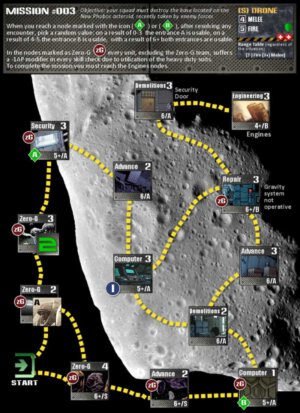
After that, select one of the enemy races at random. There are six different races included in the game. Again, all of the information you need is right there on the sheets. You also keep track of enemy combat forces and wounds on the sheet as well. The tables for generating the random encounters with the enemy are also on the sheet. This is actually excellent, as it should be fairly simple to add additional enemies and missions in the future, by simply adding a few new sheets.
Each game lasts a maximum of 30 turns, so there is a turn tracker sheet included where you also keep track of your resources and command point allocations. Command points come in handy and make your squad leader useful. You can use a command point generated by your squad leader to issue specific orders to your squad, like suppression fire or take cover, that will have different effects which can be useful. The resources are also items that can come in handy during a mission. Grenades, intelligence, demolition charges, and medikits are examples of resources you can take with you. You are only allowed eight per mission, but it is possible to find more along the way.
The basic mission sheets are all surface missions and have an entry point clearly defined. Place your squad marker on the entry point and you are ready to go.
The action is keyed on the use of random number tokens. These are 20 tokens numbered 1-6 three times, a zero, and a + token. The plus simply means you pull two additional tokens and add them together. You place these in an opaque container and will draw from this constantly to determine results for everything. There are rules for using regular dice, but I found it easier to keep track by using the tokens.
Each turn you advance the turn marker one space, then activate the units you will use to attempt to move to the next location on the map. Each map space has a specific skill and number of successes required to move your squad to that location. Let me point out that the maps are not linear, so you will have several options on the 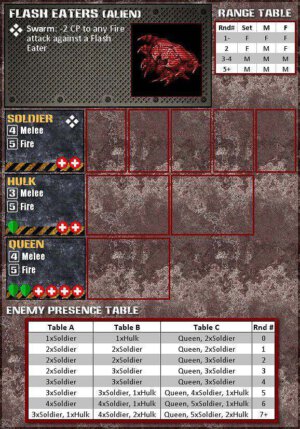
Once you advance (or not) you then pull another random number to see if an event occurs at your location. Each location lists the number required for an event to take place. If the string reads 3+/A, then an event type “A” would be triggered by drawing a number 3 or highhyer. The event types are listed right on the enemy sheets, and usually mean you will be fighting combat this turn. If no event occurs, or after the combat is over, you proceed to the next turn.
Combat is simultaneous. You put tokens on the enemy sheet to represent the number and types of enemies. You select a random number to determine whether or not this will be close combat melee or weapons fire, and then each side draws random numbers for their attacks from each unit that can attack. This works the same way as the skill checks. The random number is divided by the skill of the unit, and you cause one wound for each success. There are many other factors that can effect combat, adding + or – to the number drawn. Additionally, there is armor which can stop some wounds. After the round is resolved, if there are any other enemies left you go to the next round of combat and continue until all enemies are dead (or your squad is).
That is how the basic game works. If you accomplish your objective, or you abort the mission, you go to a debriefing where the units are assigned experience points that can be used to increase their skill levels if you get enough of them.
After playing and doing a lot of head scratching, I figured it out but thought it was really kind of ho hum. It was ok, but nothing to write home about. It was when I decided to add the advanced rules and start a campaign that this game really took off for me.
The advanced game has missions with randomly generated maps using the tiles provided. They all take place underground, so you are moving through tunnels to different locations in the “Hive”. There are rules for ammo usage, medics, additional options for issuing commands, and the campaign rules. Playing a campaign adds a squad roster sheet, where you can keep track of your entire squad, their experience, add bonuses, and the like.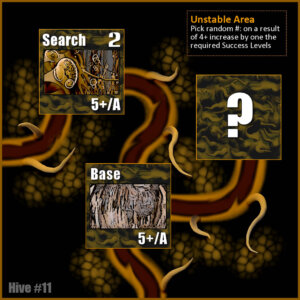
Your squad leader can earn awards too. Along with this comes the campaign sheet, where you keep track of your missions, add strategic resources, generate a specific mission in the campaign, and track your victory points. This really added a lot to the game for me, and is what reminded me of my old days of playing B-17.
My first campaign mission involved investigating three special nodes within the Hive network. You don’t know when these tiles will come out so you have to explore the complex system, adding new tiles, until you find all three. I ended up having to abort and barely escaped with half of my original team, but luckily, the wounded members survived. It was pretty exciting and I really had a great time with the advanced rules. There is more to keep track of, but it was a lot of fun even though I aborted.
The only real problems I had with the game was learning its terminology, and keeping track of the different modifiers that happen. I also wish there was some sort of backstory, as there is nothing. No info on what war is going on, or who the bad guys are, or what successfully completing the mission does for the good guys. Just select a team and go on a mission. I’m a big fan of theme, so this bugged me.
Once I got into the advanced rules the game became a hit for me and I am halfway through my first campaign already. I recommend going to the Space Infantry website, where you can print out the logs, the errata sheet (which you really do need as there are some clarifications and corrections to the rules) and a free mini- scenario game you can play with additional counters and rules. Lock ‘N Load is promising more campaigns and missions free on their website in the future.
Overall it is a very good game.
- A Dungeon Delve for Kids?: A Review of Dungeon! - Oct 24, 2022
- Better, Stronger, Faster | Descent: Journeys in the Dark Second Edition Reviewed - Oct 23, 2022
- Your Planet is Doomed!: Invasion from Outer Space Reviewed - Oct 22, 2022



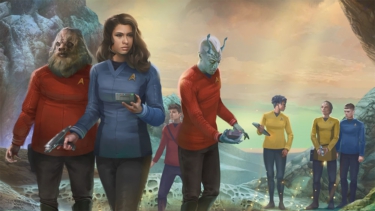
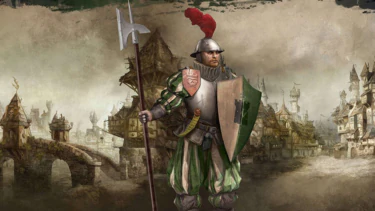
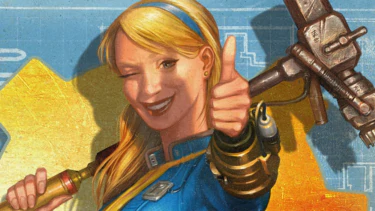



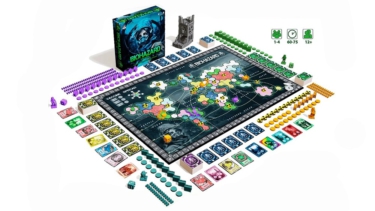
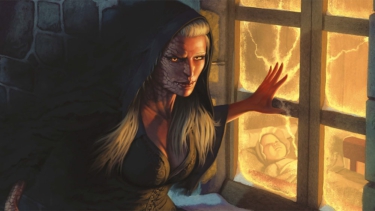

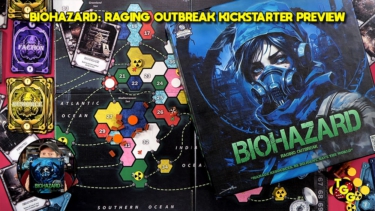
1 Comment
Good review. I went thru the fun exercise of creating my own back story. Which I am sharing on my blog.
I agree that there is some stumbling about. The revised rules are better.
I REALLY would like to have seen counters for the bad guys. Something about punting those buggers off the board is satisfying versus red X’s
I however enjoy the game. It is my Sci Fi fix of choice.